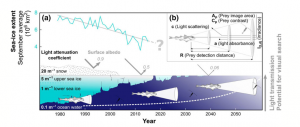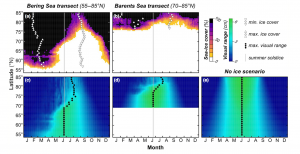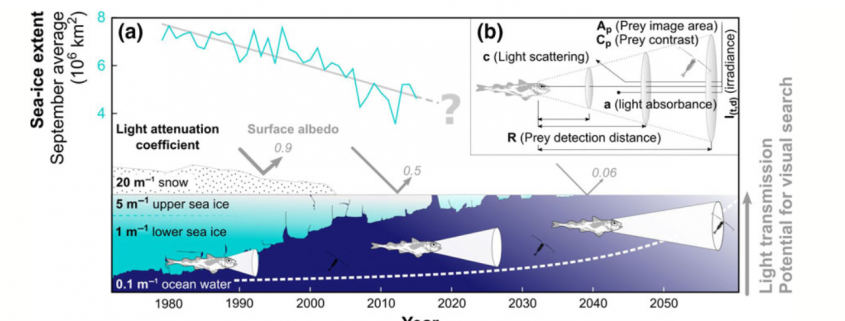Sea-ice loss boosts visual search: fish foraging and changing pelagic interactions in polar oceans
By Nicole Suren, SRC Intern
Light availability is one of the most important factors in the success of visual foraging. It can be controlled by many variables such as turbidity or weather, but in polar ecosystems ice cover and seasonality are the primary controls for light availability. Climate change has had and will continue to have a huge effect on polar ecosystems through temperature and weather changes, but one of the most notable side effects examined in this study is how increased light availability caused by receding ice and reduced snow cover will affect the success of polar visual foragers. The study modeled the success of planktivorous, visually foraging fish, with the underlying principle of the model being that increased ambient light will increase visual range, thereby making prey detectable at a larger distance and increasing foraging efficiency. The results showed that declines of polar sea ice would boost the visual search of planktivorous fish, but only seasonally. While light availability related to ice cover can be variable due to climate change, the long dark periods caused by polar seasonality are factors independent of climate, and therefore will still place limits on visual foraging during those seasons.

(a) The blue line shows how sea ice extent has decreased over the past decades, and below is a diagram demonstrating that prey will become more likely to be visually detected as the thickness of sea ice decreases. (b) A variety of factors influence prey detection, including the nature and angle of incoming light. Predator, prey, and visual range are not drawn to scale. (Langbehn & Varpe, 2017)
The models predict that several things will change due to light availability caused by loss of ice cover. First, primary productivity may increase, depending on nutrient availability. Second, seasonal feeding migrations into the poles are expected due to the removal of the limiting factor of lack of light for visual foragers. This prediction has already been verified by real-world data; increased feeding forays by Atlantic Salmon, Atlantic Mackerel, and Atlantic Herring have been recorded, and these coincide with decreasing ice cover over the past 35 years. More generally, mobile, fast-swimming predators are predicted to take advantage of these foraging opportunities the most. However, increased light availability can also increase the likelihood of planktivorous predators being spotted and predated upon by larger visual predators in a higher trophic level. This means that not only will the ideal user of these seasonal foraging grounds be mobile and fast-swimming, but they will either be apex predators or schooling fish, which can use the technique of schooling to forage in relative safety despite being visible.

The extent of sea ice is averaged from 2010-2015 in (a) and (b), and (c) and (d) show how visual range correlates with these averages. Data from the Bering Sea and the Barents Sea are shown. (Langbehn & Varpe, 2017)
No matter how efficiently visual foragers learn to take advantage of increased light availability at the poles during the summer months, the darkness of winter will still be a significant limiting factor in regards to permanent habitat expansion. Polar winters will always be long and dark, even if climate change alters the ice cover in that time. This means that the permanent inhabitants of the poles will likely remain the only permanent inhabitants due to their specialized adaptations for living in darkness, while trophic interactions are likely to change during the summer.
Work Cited
Langbehn, T. J., & Varpe, Ø. (2017). Sea-ice loss boosts visual search: Fish foraging and changing pelagic interactions in polar oceans. Global Change Biology, (November 2016). https://doi.org/10.1111/gcb.13797




Leave a Reply
Want to join the discussion?Feel free to contribute!